You'll need to monitor your spring house temperatures closely to protect stored food from dangerous bacterial growth and spoilage. During seasonal changes, daily temperature swings can vary by up to 6°F or more, putting your food at risk when temps rise above 40°F for over 6 hours. This fluctuation creates ideal conditions for harmful bacteria to multiply rapidly, potentially compromising food safety and reducing shelf life. Regular temperature checks, at least twice daily, help you maintain proper storage conditions between 32-50°F and humidity levels of 80-90%. Discovering the right monitoring techniques can make all the difference in preserving your food's quality and safety.
Natural Cooling System Benefits
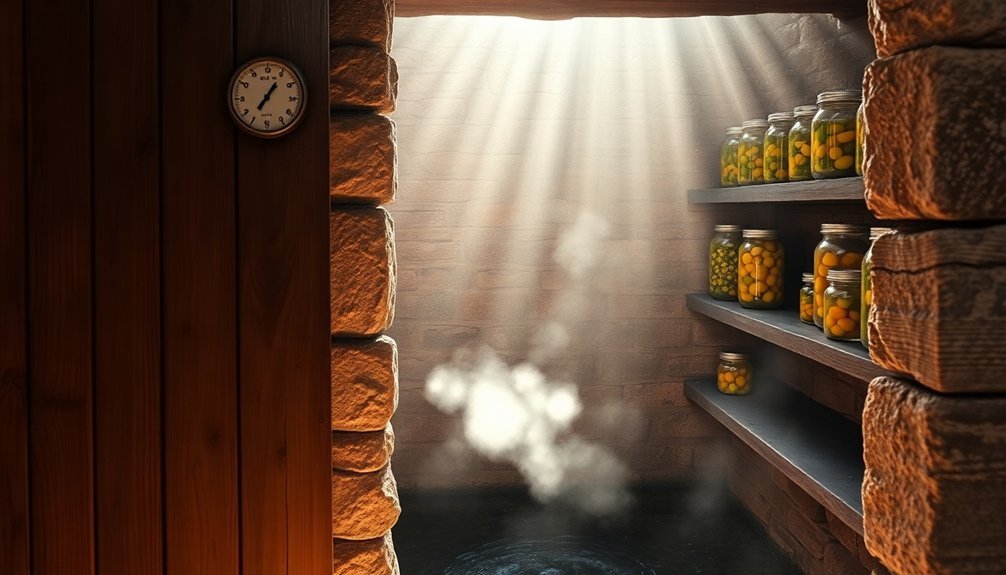
Why rely on expensive electrical cooling systems when nature offers an efficient alternative?
Spring houses provide passive cooling mechanisms that can lower temperatures up to 19°F below the surrounding environment without requiring electricity. You'll only need a small amount of water to activate the combined benefits of radiative cooling, evaporative cooling, and thermal insulation. The system's three-layer design uses specialized aerogel and hydrogel materials for maximum cooling efficiency.
You can greatly extend your food's shelf life through this natural cooling approach. In temperate climates, you'll preserve fruits and vegetables for an additional 2-15 days, while the system maintains ideal humidity levels between 70-100%.
This moisture balance prevents your produce from drying out while keeping it at safe temperatures.
The environmental and economic advantages are considerable. You'll reduce your energy consumption while effectively keeping food out of the danger zone (40-140°F), preventing harmful bacteria growth.
This system's particularly valuable if you're living in remote areas or dealing with unreliable power supplies. Since it uses low-cost materials and can be powered by natural phenomena like solar energy, you're not only protecting your food but also contributing to climate protection goals by minimizing your cooling energy footprint.
Spring Water Temperature Fluctuations
You'll need to monitor your spring house's daily temperature swings, which can vary by up to 6°F normally and even more during intense summer heat.
Maintaining proper temperature monitoring protocols helps prevent foodborne illnesses and ensures food safety compliance.
Your food storage conditions will change as seasonal warmth influences spring water temperatures, with the highest temperatures occurring in summer months and lowest in winter.
You can better manage your storage environment by understanding how to control the flow of cool spring water through your spring house, adjusting it based on daily and seasonal temperature patterns.
Daily Temperature Range Impact
Throughout the spring season, daily temperature fluctuations can greatly impact food storage conditions in your spring house. When temperatures vary considerably, you'll notice accelerated chemical reactions that can double for every 10°C increase, potentially compromising your stored food's quality. These fluctuations won't just affect the surface level – they'll penetrate deep into your food items, causing structural changes and increasing spoilage risks. Monitoring water activity levels regularly will help detect moisture changes that could compromise shelf life stability.
| Temperature Impact | What You'll Notice |
|---|---|
| Chemical Changes | Faster nutrient loss, flavor changes |
| Microbial Growth | Increased bacterial activity above 85°F |
| Texture Problems | Moisture migration, clumping |
| Food Safety | Higher spoilage risk in canned goods |
| Storage Life | Reduced shelf life, quality degradation |
You'll need to monitor these daily temperature swings carefully, as they can create ideal conditions for bacterial growth and accelerate food breakdown. Even if your spring house typically maintains cool temperatures, sudden changes can trigger moisture migration and texture changes in your stored foods. Pay special attention to canned goods, as temperature shocks above 85°F can compromise their safety and lead to thermophilic bacteria growth. Regular monitoring helps you maintain favorable storage conditions and prevent premature food spoilage.
Seasonal Warmth Affects Storage
As spring warmth builds, the temperature of water entering your spring house can shift dramatically, directly impacting your food storage conditions.
You'll notice these fluctuations especially during mid-day when ambient temperatures rise, potentially compromising the safety and quality of your stored foods. Temperature variations between 70 and 80+ degrees can quickly affect food quality, reducing shelf life and increasing the risk of spoilage.
You've got to be particularly vigilant about monitoring these seasonal changes, as they directly influence the growth of harmful bacteria.
Using thermometers consistently will help you identify trouble spots and maintain safer storage conditions. When you're checking temperatures, pay special attention to areas near water inflow points where fluctuations are most noticeable.
- Your family's health is at stake – inconsistent temperatures can lead to foodborne illness and put loved ones at risk
- Your investment in stored food could be lost – spring temperature changes can destroy months of careful preservation efforts
- Your peace of mind matters – knowing your spring house maintains proper temperatures lets you rest easier about your food security
Remember to check temperatures more frequently during spring shifts, and adjust your storage arrangements accordingly.
Cool Water Flow Control
The relentless flow of spring water requires careful management to maintain stable storage temperatures. You'll need to monitor and adjust the water flow to prevent temperature fluctuations that can compromise your stored food's safety and quality.
When spring water temperatures vary, they can create dangerous conditions where bacteria thrive, especially in the 40-140°F danger zone.
To maintain ideal conditions, you'll want to install reliable thermometers and establish a monitoring system. Keep detailed temperature logs to track patterns and identify potential issues before they affect your food storage.
You should aim to keep your spring house below 75°F for non-perishable items, while maintaining temperatures between 34-40°F for refrigerated goods.
Control your spring's water flow to prevent rapid temperature changes that can lead to condensation and subsequent mold growth.
Remember, consistent temperatures aren't just about preventing spoilage – they're essential for maintaining your food's nutritional value, flavor, and texture.
If you notice temperature variations between 70-80°F, you'll need to adjust your water flow immediately, as these fluctuations can quickly impact food quality and potentially damage your storage facility.
Seasonal Food Storage Challenges
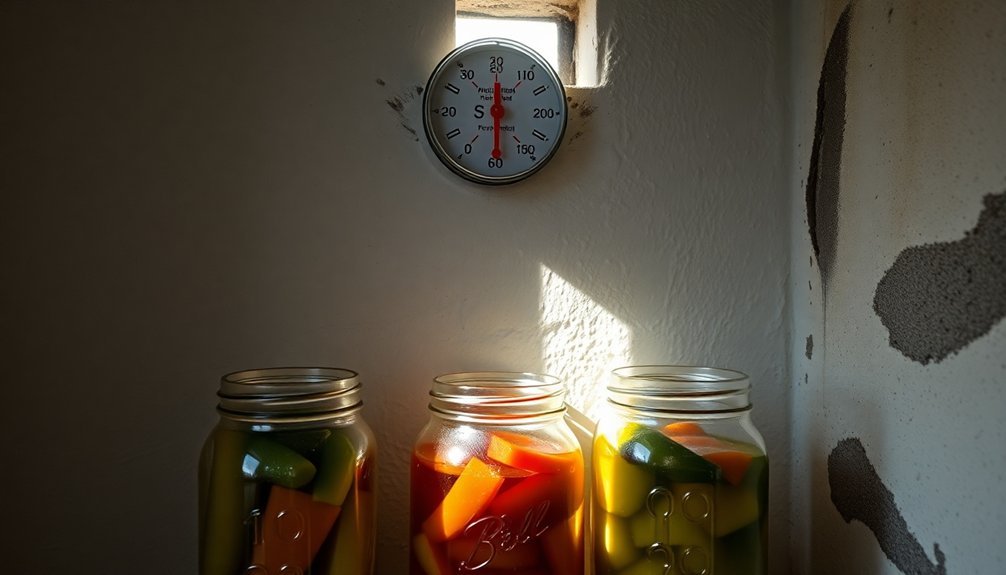
You'll need to watch out for temperature fluctuations in your spring house storage, as spring's variable weather can quickly compromise food safety and quality.
Managing humidity becomes tricky during this season when warm days mix with cool nights, creating condensation that can affect stored produce.
Spring frost poses an additional threat to your food storage, as sudden cold snaps can damage temperature-sensitive items and create unexpected freezing zones within your storage space.
Temperature Fluctuation Risks
During seasonal changes, food storage temperatures in spring houses can fluctuate dramatically, creating serious risks for preserved goods.
You'll find that even small temperature variations between 4.4°C and 12°C can trigger rapid bacterial growth, potentially compromising your food's safety. When temperatures rise, chemical reactions double their speed for every 10°C increase, leading to faster food deterioration and nutrient loss.
Your stored food faces these critical risks:
- Dangerous bacteria can multiply rapidly in your preserved foods when temperatures fluctuate, potentially making your family sick.
- Your carefully stored seasonal produce might spoil prematurely, wasting both food and money.
- The nutritional value of your preserved goods could decline considerably, leaving you with less healthy food for your family.
To protect your stored foods, you'll need to monitor spring house temperatures vigilantly.
Pay special attention during transfers between storage areas and when opening doors frequently.
Remember that proper temperature control isn't just about keeping food cold – it's about maintaining consistent temperatures to prevent bacterial growth and preserve food quality.
Consider using preservation methods like canning and drying for items that are particularly sensitive to temperature changes.
Humidity Control Challenges
Moisture levels in spring house storage areas create a complex battle for food preservation. If you don't monitor and control humidity properly, you'll face significant challenges that can compromise your stored food's safety and quality.
You'll notice that uncontrolled humidity directly impacts your food's shelf life. When moisture levels are too high, you're creating an ideal environment for bacteria and mold growth, which can lead to foodborne illnesses.
Conversely, when humidity drops too low, you'll find your fresh produce dehydrating and losing nutritional value.
Your food's quality will suffer noticeably under poor humidity conditions. You'll see vegetables wilting, bread becoming stale, and meats losing their tenderness.
Even your dry goods aren't safe – grains and spices can clump or spoil when exposed to improper moisture levels.
Additionally, you're risking damage to your storage equipment. High humidity will cause corrosion and rust, forcing your refrigeration systems to work harder.
This means you'll face increased maintenance costs and higher energy bills. To protect both your food investments and equipment, you'll need to implement proper humidity monitoring and control measures in your spring house storage areas.
Spring Frost Effects
Beyond managing indoor humidity, spring frost presents a significant threat to your stored food supply. When temperatures fluctuate between warm and cold periods, your preserved fruits and vegetables become vulnerable to quality degradation.
You'll need to closely monitor your storage temperatures, as sudden cold snaps can affect both fresh and preserved foods, particularly if you're storing them in areas like spring houses or root cellars.
To protect your food storage during spring's unpredictable weather, you'll want to implement proper preservation techniques and maintain consistent temperatures. Consider using airtight containers and protective wrapping methods like cling film or aluminum foil to prevent cross-contamination and preserve food quality longer.
If you're storing locally sourced produce, you'll need to be especially vigilant as these items may not have been treated with commercial preservation methods.
- Your entire season's worth of preserved food could be compromised by just a few days of improper temperature management.
- The fresh produce you've carefully stored might develop frost damage, leading to rapid spoilage.
- Your family's food security depends on maintaining proper storage conditions throughout spring's temperature fluctuations.
Bacterial Growth Prevention Methods
Preventing bacterial growth in your spring house requires four essential control measures: temperature regulation, time management, moisture control, and food-specific handling practices.
You'll need to keep foods out of the danger zone between 40°F and 140°F, where bacteria thrive. Store cold items at 40°F or below and maintain hot foods at 140°F or higher.
Pay special attention to the critical range of 70°F to 125°F, where bacterial growth accelerates rapidly.
Don't let food sit out for more than two hours (one hour in warm conditions). When you're cooling hot foods, use the two-step method to move through the danger zone quickly. Always marinate foods in the refrigerator, not on the counter.
Control moisture by storing foods in sealed containers or bags, and regularly clean your storage areas to prevent excess moisture buildup.
Remember that bacteria need water to multiply, so keep dry foods dry and monitor humidity levels.
Consider each food's characteristics when storing. While acidic foods like lemons naturally resist bacteria, neutral items like meat and vegetables need stricter temperature control.
Keep eggs in their cartons in the main compartment, not the door, for consistent temperature maintenance.
Optimal Temperature Monitoring Equipment
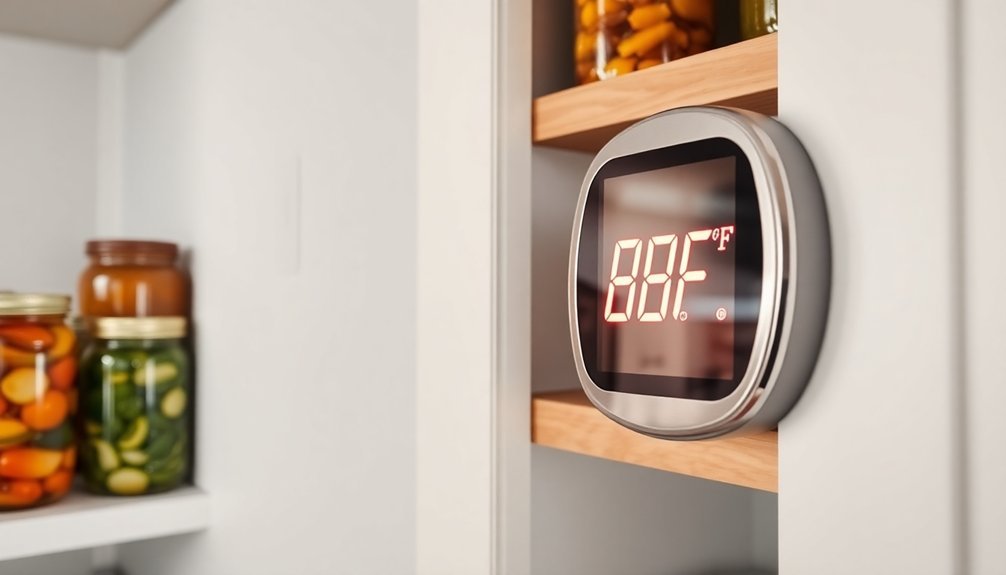
Proper temperature monitoring equipment serves as your first line of defense in maintaining safe food storage conditions in your spring house.
You'll want to invest in IoT-based or Bluetooth-enabled monitoring systems that provide real-time data access and automatic alerts when temperatures deviate from safe levels. These smart systems can communicate with your smartphone or tablet, letting you check conditions remotely while reducing the risk of human error.
For hands-on temperature verification, you'll need reliable thermometers. Digital 2-Point Thermometers or Dual Temp Digital models allow you to monitor multiple areas simultaneously, while long-stem versions guarantee accurate readings in hard-to-reach spaces.
Consider NIST-certified devices to assure measurement accuracy.
- Don't risk your family's health with unreliable temperature readings – invest in monitors with high-low alarm functions
- Sleep soundly knowing your stored food is safe with 24/7 automated monitoring and instant alerts
- Take control of your spring house's environment with precise, professional-grade equipment that won't let you down
Data loggers and cloud storage capabilities enable you to track temperature patterns over time, helping you identify and address any recurring issues before they compromise your food storage.
Cold Storage Space Management
Managing your spring house's cold storage space efficiently can make the difference between chaos and organization. You'll want to maximize every inch of available space by implementing smart storage solutions that work within your spring house's unique layout.
Start by utilizing vertical space effectively with adjustable shelving systems that can accommodate different-sized containers and products. You can install mezzanine platforms for lighter items, making use of overhead space that might otherwise go unused.
Consider implementing mobile storage systems that can compact together when not in use, giving you more flexibility with your limited space.
To optimize temperature control and energy efficiency, divide your spring house into distinct temperature zones based on different food storage requirements. You'll need to conduct regular temperature mapping to identify any hot spots or cold pockets that could affect food preservation.
Don't forget to install high-speed or strip doors between zones to minimize heat transfer and maintain consistent temperatures throughout your storage areas.
Using sensors and control systems can help you manage energy demand more effectively, allowing you to adjust cooling levels during off-peak hours while ensuring your stored food remains at safe temperatures.
Traditional Preservation Techniques
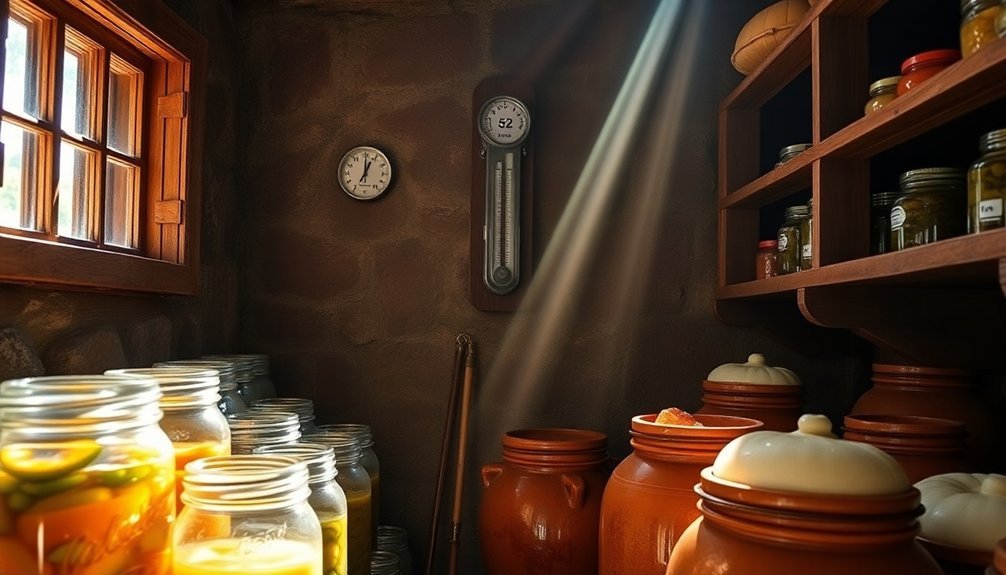
You'll find root cellars and natural cold zones are time-tested methods that align perfectly with spring house preservation techniques.
These storage methods take advantage of the earth's natural cooling properties, much like traditional drying and curing practices used throughout history.
Your spring house can work alongside root cellars to create multiple preservation zones, giving you flexible options for storing different types of produce at their ideal temperatures.
Root Cellar Storage Methods
Root cellars stand as time-tested champions of food preservation, offering an energy-efficient way to store fruits and vegetables throughout the year. You'll find that maintaining temperatures between 32-40°F and humidity levels of 80-90% creates the perfect environment for extending your harvest's shelf life.
In these dark, cool spaces with dirt floors, you're able to store everything from root vegetables to apples while minimizing energy costs.
To maximize your root cellar's effectiveness, you'll want to implement proper storage methods. Separate your vegetables based on their specific needs, using 5-gallon buckets or larger containers buried in the ground for root vegetables. Monitor temperatures regularly with thermometers, and guarantee proper ventilation to prevent ethylene buildup.
- You'll feel a deep connection to your ancestors as you practice these traditional preservation methods that have sustained families for generations.
- You'll experience the satisfaction of reducing your carbon footprint while maintaining a sustainable food supply.
- You'll gain peace of mind knowing you've created a reliable food security system for your family.
Keep your cellar clean, check for pests regularly, and maintain proper humidity levels to prevent food spoilage and guarantee long-term storage success.
Natural Cold Preservation Zones
When exploring traditional cold storage methods, natural preservation zones provide an effective way to maintain ideal temperatures between 32-50°F for your harvested produce.
You'll want to identify areas that can maintain temperatures between 32-40°F for root vegetables while preventing freezing that would damage your stored crops.
Earth-insulated spaces offer natural temperature stability and humidity control, helping you maintain the essential 85-95% humidity levels most root vegetables need.
You can utilize in-ground storage options like trenches, mounds, or pits to take advantage of the earth's natural insulation. For root crops, you'll find they can often remain in their growing location, though you shouldn't add mulch until the soil has cooled to prevent decay.
Remember to separate your storage zones based on vegetable types.
Store your potatoes in slightly lower humidity than other root vegetables, and keep apples and tomatoes in separate areas.
Onions, garlic, and hot peppers need cool, dry conditions, while root vegetables like carrots, beets, and parsnips thrive in cold, moist environments.
Some crops, including parsnips and turnips, actually benefit from light freezing, improving their flavor.
Critical Temperature Danger Zones
Understanding the temperature danger zone is essential for spring house food storage. When your stored food falls between 41°F and 135°F, bacteria can multiply rapidly, doubling in number every 20 minutes.
You'll need to monitor your spring house temperatures vigilantly, as this range presents significant risks for foodborne pathogens like salmonella and E. coli.
For cold storage in your spring house, you must maintain temperatures at or below 40°F to keep food safe. If temperatures rise above this threshold, you've got a limited window of about 6 hours before food safety becomes compromised.
Check temperatures every 2 hours, and if they reach 70°F, you'll need to discard the affected items immediately.
- Your family's health depends on proper temperature control – imagine the distress of seeing loved ones suffer from food poisoning.
- You've invested time and resources in food storage – don't let bacterial growth destroy your preparations.
- Your spring house can be a reliable food storage solution, but only if you're diligent about temperature monitoring.
Spring House Design Considerations
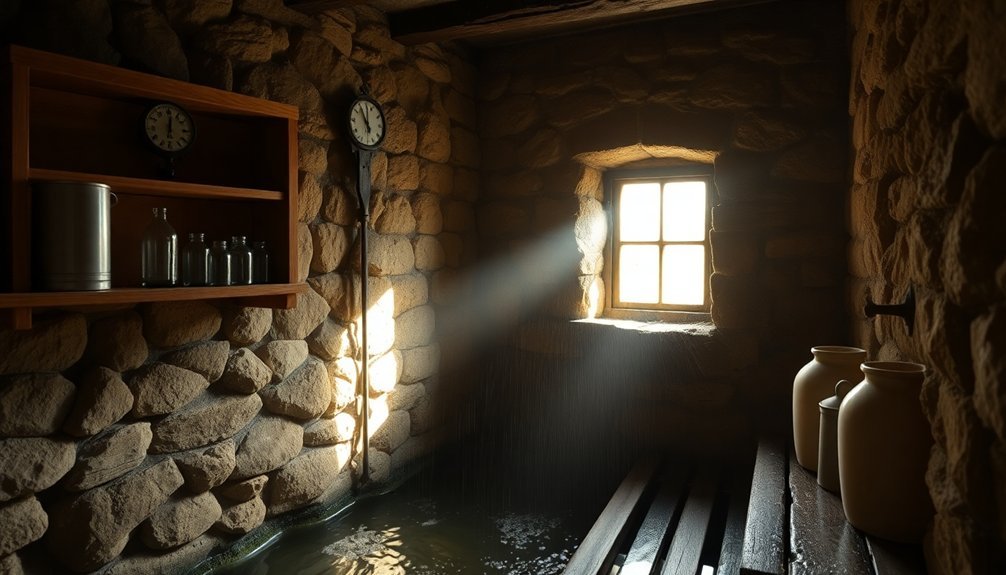
Building an effective spring house requires careful attention to both structural design and natural cooling mechanics. You'll need to select durable stone materials that can withstand constant moisture while maintaining cool temperatures. The structure should ideally be built into a hillside or near a natural spring to maximize natural insulation.
Your design must incorporate a water channel along the interior walls to direct spring water flow, which maintains a consistent temperature of around 50°F (10°C). You'll want to include built-in shelving and rafters for efficient storage organization, allowing you to separate different food items and prevent cross-contamination. The single-room layout helps maintain uniform cooling throughout the space.
When planning your spring house, consider how you'll protect the water source while ensuring easy access to stored items. Position the structure in a shaded area to minimize external heat gain, and include minimal ventilation to prevent moisture buildup without compromising the cool environment.
You'll need to create designated spaces for items that require direct water immersion, like milk containers, while keeping other products on elevated shelves or hanging from rafters for ideal temperature control.
Daily Temperature Recording Practices
A spring house's temperature monitoring requires strict daily recording practices to maintain food safety and prevent spoilage. You'll need to check temperatures at least twice daily – once when you open and again when you close. Each time you record a reading, make sure to document the time, specific storage area, temperature reading, and your initials in the log book.
This detailed documentation helps you track patterns and identify potential issues before they become serious problems. Your temperature logs serve as essential evidence for health inspections and provide accountability for your food storage practices.
You'll want to use properly calibrated thermometers and consider implementing digital monitoring tools to streamline the process. Remember to keep foods out of the danger zone (40°F-140°F) to prevent bacterial growth.
- Don't risk your family's health – a missed temperature check could lead to dangerous foodborne illness
- Take pride in maintaining detailed records that protect your stored food investment
- Feel confident knowing you're following time-tested safety protocols that generations have relied upon
Cross-reference your temperature logs with cleaning schedules and address any deviations immediately to maintain ideal food storage conditions.
Frequently Asked Questions
How Do Power Outages Affect Spring House Temperature Stability?
Power outages can disrupt your spring house's temperature stability, making it harder to keep food safely chilled. You'll need to monitor temps closely, as lack of electricity affects cooling systems and natural water flow.
Can Spring Houses Be Used Effectively in Desert Climates?
You can use spring houses in desert climates, but they're less effective due to limited water sources and high ambient temperatures. You'll need additional cooling methods and careful site selection near natural springs.
What Backup Cooling Methods Work Best During Spring House Maintenance?
During spring house maintenance, you'll find ice baths and cooling paddles most effective as backup methods. They're portable, don't need electricity, and can maintain safe food temperatures while you're completing necessary repairs.
How Does Spring Water Mineral Content Impact Food Storage Temperatures?
Spring water's mineral content doesn't directly affect your food storage temperatures. You'll need to focus on proper temperature control and storage practices independently, as minerals only impact water quality, not cooling effectiveness.
Are Modern Cooling Systems More Reliable Than Traditional Spring Houses?
You'll find modern cooling systems are more reliable than spring houses, offering precise temperature control, real-time monitoring, and backup systems. They're not dependent on natural water sources or seasonal temperature variations.
In Summary
You'll find that monitoring spring house temperatures is essential for ensuring food safety and maximizing storage effectiveness. By tracking daily temperature fluctuations, you're protecting your stored goods from dangerous bacterial growth and spoilage. Whether you're using traditional preservation methods or modern monitoring equipment, maintaining proper temperature control in your spring house helps preserve your food supplies through seasonal changes while providing reliable natural cooling.

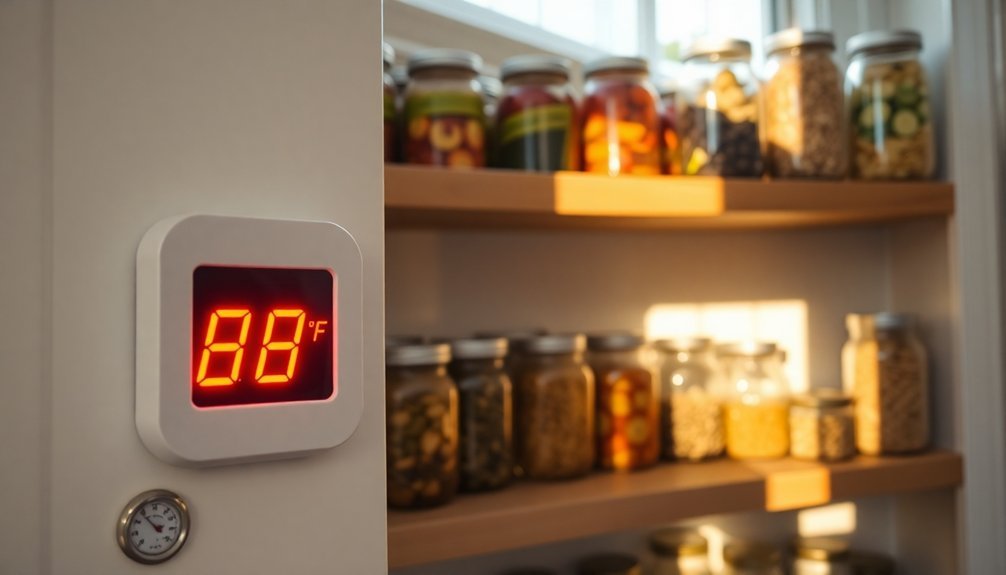



Leave a Reply